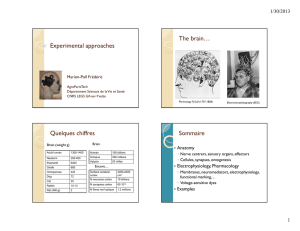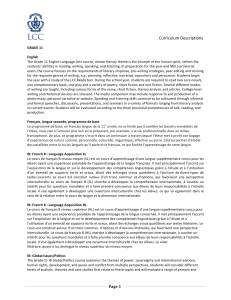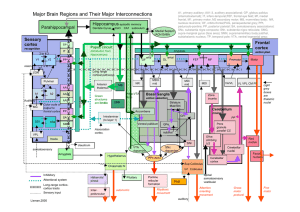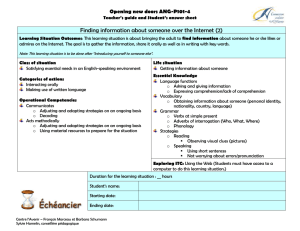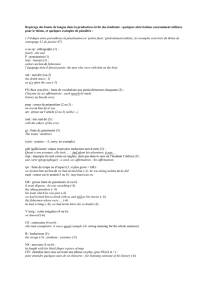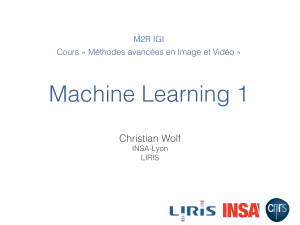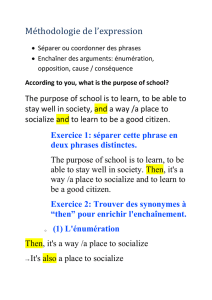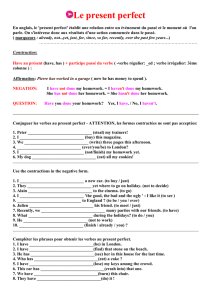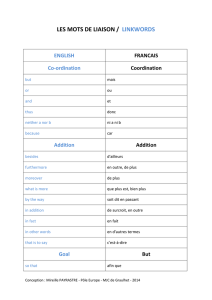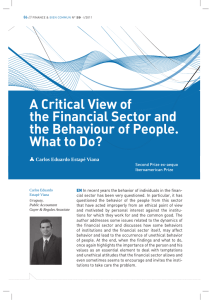Cours Boussaoud Partie 02.pptx
publicité
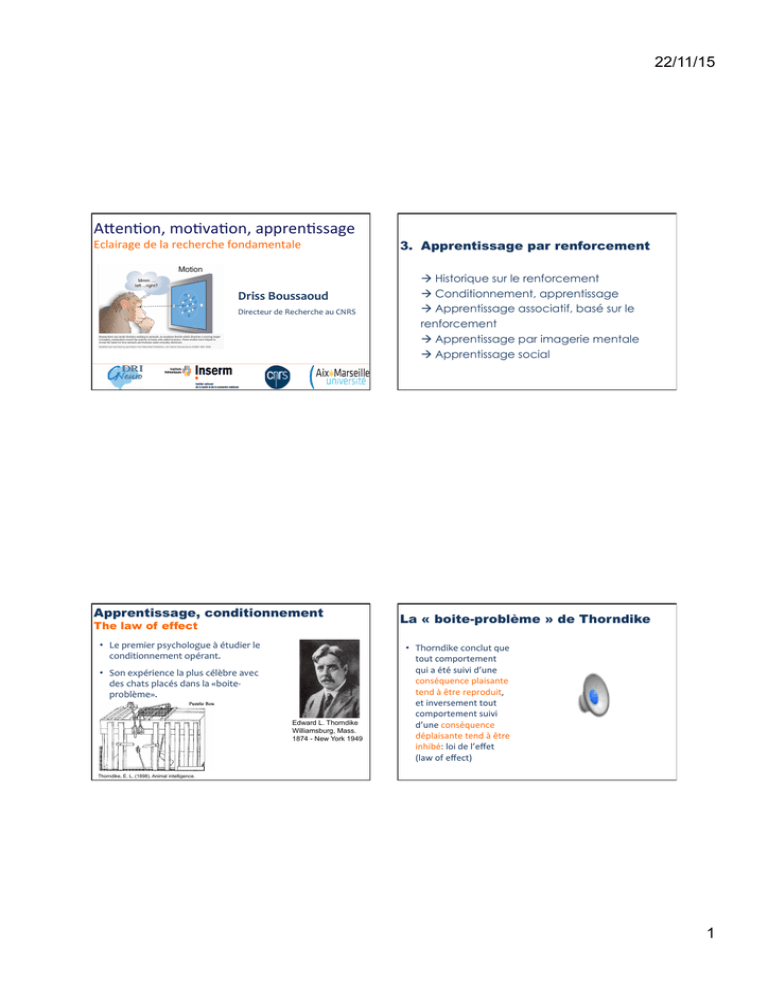
22/11/15 A"en%on, mo%va%on, appren%ssage Eclairage de la recherche fondamentale Driss Boussaoud Directeur de Recherche au CNRS Apprentissage, conditionnement The law of effect • Le premier psychologue à étudier le conditionnement opérant. • Son expérience la plus célèbre avec des chats placés dans la «boite-­‐ problème». Edward L. Thorndike Williamsburg, Mass. 1874 - New York 1949 3. Apprentissage par renforcement à Historique sur le renforcement à Conditionnement, apprentissage à Apprentissage associatif, basé sur le renforcement à Apprentissage par imagerie mentale à Apprentissage social La « boite-problème » de Thorndike • Thorndike conclut que tout comportement qui a été suivi d’une conséquence plaisante tend à être reproduit, et inversement tout comportement suivi d’une conséquence déplaisante tend à être inhibé: loi de l’effet (law of effect) Thorndike, E. L. (1898). Animal intelligence. 1 22/11/15 Deux formes d’effet : renforcement et punition, bases du conditionnement Renforcement Positif Négatif Punition La probabilité de réponse augmente La probabilité de réponse diminue Récompense Stimulus aversif appliqué Stimulus aversif retiré Burrhus Frederic SKINNER Récompense retirée Classique Réflexe Conditionnement classique versus opérant Cage de Skinner light bar water Susquehanna, Penn. 1904, Cambridge, Mass. 1990 food tray De l’apprentissage à la mémoire • Le conditionnement conduit à la mémorisation des relations entre stimuli ou entre stimuli et comportements; Opérant Volontaire Récompense dispensée indépendamment du comportement du rat Le comportement du rat détermine la récompense • Le conditionnement opérant conduit à la formation de la mémoire procédurale, ou la mémoire des habitudes (habit memory); • Une mémoire à long terme, dont le support neuronal est le cortex frontal, les ganglions de la base et les structures du lobe temporal médian; 2 22/11/15 Les différents types de mémoire Habiltés motrices humaines Mémoire A court terme « Mémoire de travail » A long terme Cortex préfrontal Mémoire des faits et des événements Système limbique Mémoire des savoir-­‐faire Système fronto-­‐striatal et cervelet ... Le concept d’apprentissage Ø L’apprentissage est un changement du comportement qui résulte de l’expérience passée; Ø La capacité d’apprendre existe chez les espéces animales (animal learning theory) et peut être programmée dans des machines (machine learning); Ø La prentissage vise à réduire l’écart entre la conséquence attendue d’un comportement et la conséquence produite; Ø Il résulte de la plasticité neuronale, ou neuroplasticité. La neuroplasticité Ø Elle existe même dans le cerveau adulte: Les neurones peuvent modifier leurs propriétés individuelles et leurs interactions, par le biais de modifications synaptiques (loi de Hebb) Hebb’s law: “neurons that fire together, wire together… they form cell assemblies” Ces modifications permettent d’apprendre et de former de nouveaux souvenirs, mais aussi la récupération fonctionnelle. 3 22/11/15 L’apprentissage, un champ multidisciplinaire Principaux types d’apprentissage Expérience individuelle Ø Neurosciences, sciences cognitives, psychologie, médecine de la réhabilitation, sciences de l’éducation… Ø L’intelligence artificielle, la robotique, sciences de l’ingénieur, l’informatique, mathématiques et physique; S R Apprentissage social Apprentissage par imagerie mentale O Stimulus Réponse Conséquence Ø Il est basé sur le renforcement. Circuits de l’apprentissage par renforcement Neuroplas%cité & circuits de la dopamine Cortex Frontal +/- Cortex + + + Striatum +/- + • Récompense/Plaisir • Codage de l’erreur • Mo%va%on/Décision - Cortex Ganglions de la base GPe SNc - + Thalamus - Dopamine STN + Basal ganglia Cortico-basal ganglia loops + GPi/SNr - Thalamus 4 22/11/15 Neuroplasticité & circuits de la dopamine Appren%ssage associa%f -­‐ Faire du vélo -­‐ Code de la route -­‐ Lecture ... Dopamine codage de l’erreur de prediction L’erreur de prédiction est l’écart entre la conséquence attendue et la conséquence produite par le comportement. • La décharge des neurones dopaminergiques déchargent d’autant plus fortement que l’erreur de prédiction est grande; • Ils projettent sur le striatum et le cortex frontal, dont ils modifient l’activité pour adapter le comportement, de sorte à réduire l’erreur de prédiction. Wolfram Schultz and Anthony Dickinson (2000). NEURONAL CODING OF PREDICTION ERRORS. Annu. Rev. Neurosci. 2000. 23:473–500. Dopamine modifies synaptic efficacy (Hebb) in frontal cortex and basal ganglia -­‐ Memory A retenir: • Les neurones dopaminergiques jouent un rôle central dans l’apprentissage par renforcement; • Ils déchargent en relation avec la récompense (renforcement) et tout événement de l’environnement qui la prédit (motivation); DA • La DA modifie la transmission synaptique dans les régions cibles (cortex frontal cortex et ganglions de la base) à mémorisation. 5 22/11/15 1,2 Action Conséquence @ 16 Behavior 14 1 12 Correct (%) Stimulus Modifications neuronales dans le striatum 0,8 10 0,6 8 6 0,4 0,2 H080201(1,2)b LN 4 Activity Activity 2 0 0 1 6 11 16 21 26 31 36 Blocs de 5 consecutive trials 41 46 Activity (Sp/s) ♣ Activity (Sp/s) Etude de l’apprentissage par renforcement chez le singe Trials ♠ Hadj-­‐Bouziane & Boussaoud, 2003 Action Modifications neuronales dans le cortex frontal 0.8 sec Reward Deux catégories de neurones Les neurones de l’exploration BEHAVIOR ACTIVITY Chen & Wise 1995. Les neurones de la consolidation 6 22/11/15 Brovelli A, Laksiri N, Nazarian B, Meunier M and Boussaoud D. Cerebral Cortex, 2008, 18:1485-1495 Apprentissage associatif IRM fonctionnelle chez l’homme Prédiction de l’erreur 1er essai incorrect 1er essai correct Plusieurs aires se partagent le travail Brovelli A, Laksiri N, Nazarian B, Meunier M and Boussaoud D. Cerebral Cortex, 2008, 18:1485-­‐1495 Synthèse: dynamique neuronale Pendant l’apprentissage, l’activation se déplace des régions antérieures (cognitives) vers les régions sensorimotrices: exécution automatique de la tâche. Varieties of learning Practice, experience S R Social learning Mental rehearsal O Consolidation exécution Exploration BEH Stimulus Response Outcome ACT Mémoire de travail Mémoire à long terme 7 22/11/15 Appren%ssage social La découverte des neurones miroirs Psychologie sociale Monkey does Des bla"es à l’homme, le comportement est régulé par le contexte social. • La présence des congénères facilite le comportement de la bla"e pour la réponse dominante, automa%que (tâche facile). • Elle ralen%t la réponse non dominante (tâche difficile) Conclusion de Zajonc (1965) Rizzolatti et al., 1992. Effet dof e lthe ’audience le stroop Impact Attentivesur Audience on the Stroop Effect RT (msec) La facilitation sociale Un phénomène ubiquitaire Monkey sees doing 880 860 840 820 800 780 760 740 720 700 Incongruent Words Control Signs Alone Attentive Audience Item Type x Context : p < .002 8 22/11/15 Même réseau que l’apprentissage par renforcement Avec le système miroir Quel réseau cérébral est impliqué? 4 TE Apprentissage individuel P P Système miroir P Apprentissage par observation Cortex Frontal Réseau de l’appren%ssage Striatum X=-­‐10;y=14;z=4 Monfardini et al., 2013 Monfardini et al., 2013 Hadj-Bouziane et al. Visuo-motor learning in Parkinson’s disease assess between- and within-groups differences. The p-value for significance of these post-hoc t-tests was set at a Bonferroniadjusted p < 0.025. Comparisons involving retest involve only the 9 controls that were tested twice like patients, whereas comparisons performed on test involved all 20 controls. In controls, Pearson’s correlation analyses were used to determine whether age and strategy use predicted learning scores on test (these analyses were not performed on retest due to the small number of subjects involved). In patients, Pearson’s correlation analyses were used to determine the influence of age, strategy use, disease stage, and neuropsychological variables on learning scores, and these analyses were performed on both test and retest. Table 3 | Age, education level, disease stage, and conditional learning RESULTS The 20 controls matched the 16 PD patients for age (t34 = 0.6, p = 0.58), and education level (t34 = 0.7, p = 0.48). Patients’ response times were expectedly longer than controls reaching 1519 ± 344 ms on test and 1507 ± 108 ms on retest compared to 1286 ± 233 ms and 1118 ± 60 ms, respectively, in controls (group effect: F(1, 23) = 8.4, p = 0.008; session effect and interaction, Fs ≤ 0.4, ps > 0.51). They remained, however, well under 3 s, indicating that the learning deficit described below was not due do a motor inability to respond within the imparted time. More surprising was the lack of effect of medication. As summarized in Table 3, in both the PD-1 (test off–retest on) and PD-2 (test on–retest off) subgroups, most conditional learning measures improved slightly on levodopa relative to off levodopa. Yet, none of these on/off differences reached significance whether the PD-1 and PD-2 subgroups were considered separately or together. The results below therefore focus on the session effect (test vs. retest), which, unlike medication, markedly affected patients’ performance. Apprentissage social & individuel, même réseaux cérébraux A PD-1 (n = 8) Age (years) Mean SEM PD-2 (n = 8) Mean SEM 54.5 2.8 56 3 Education (years) 9.9 0.5 12.9 1.5 Hoehn & Yahr off (/5) 3.1 0.1 3.4 0.3 TEST OFF ON Reaction times (ms) 1601 136 1438 107 Trials per set (max: 50) 39.9 2.9 33.2 4.2 Search errors 13.2 2 6.7 1.2 Retention errors 10.5 2.2 9.2 Strategy score 14.8 4.7 24.6 RETEST Reaction times (ms) ON 1482 3.3 5.8 OFF 170 1532 143 Trials per set (max: 50) 28 3.9 30 3.7 Search errors 8.1 2.5 6.6 1.4 Retention errors 5.8 2.2 6.5 2.7 25.3 6.2 34.7 7.3 Appren%ssage sans dopamine? L’appren%ssage social ac%ve deux systèmes: A scores (mean ± sem) of patients according to medication status. Strategy score The counterbalanced within-subject design revealed no reliable effect of the acute challenge of levodopa. à Le système miroir, pour omprendre Thec results are detailed for trials to criterion; unless otherwise GLOBAL CONDITIONAL LEARNING PERFORMANCE indicated, errors to criterion yielded the same conclusions. impairment and à Le sGlobal ystème ddisease u stage X As illustrated in Figure 2, patients systematically performed more poorly than controls (group effect, F renforcement, pour = 5.8, p = 0.02) although, like controls, they improved across sessions (session effect F = 13.5, p = 0.001; group × session interaction, apprendre F = 0.5, p = 0.83 ns). They required 44% more trials per (1, 23) (1, 23) (1, 23) P set on test (t34 = 3.8, p = 0.001), and 36% more trials per set on retest (t23 = 2.1, p = 0.02). More advanced disease stage as evaluated by Hoehn & Yahr on medication scores was correlated with more trials per set on test (test: r = 0.50, p = 0.05), and a combination of more trials per set (r = 0.65, p = 0.006), more errors per set (r = 0.67, p = 0.005) and poorer strategy scores on retest (r = −0.53, p = 0.03). We did not find reliable correlation between patients’ impairment on conditional learning and their neuropsychological scores, but this negative result should be taken with caution as a complete neuropsychological evaluation could only be obtained from only 10 of our 16 patients. Sous forte modula%on sociale: je me compare à vous en permanence ! Potential influence of age and strategy Controls seemed more vulnerable to aging than patients (Figure 3A). Only in controls, were scores positively correlated Frontiers in Human Neuroscience FIGURE 2 | Global learning impairment in PD patients relative to controls. Number of trials (trials per set, mean, and SEM) to reach or fail to reach criterion of three consecutive correct responses for all 3 associations within the imparted 50 trials (maximum) on the test and retest session; the Hadj-Bouziane, Meunier, Boussaoud, 2013 higher the scores, the worse the performance. For each session, scores were averaged over three trios of visuo-motor associations (∗∗∗ p = 0.001; ∗ p = 0.05: between group differences as revealed by two-sample t-tests). Sans dopamine, l’appren%ssage est fortement altéré. with age (errors: r = 0.46, p = 0.04 compared to r = 0.13, p = 0.63 ns in patients). Also, only in controls, did performance deteriorate after 60 years of age (t18 = 3.2, p = 0.005; patients: t14 = 0.8, p = 0.43 ns). The global impairment reported above www.frontiersin.org January 2013 | Volume 6 | Article 351 | 5 9 22/11/15 La dopamine mise en équa%on Formule à 3 variables: S environnement (s%mulus) A ac%ons (réponse) R conséquence (récompense) Adapter A à S pour opFmiser R Modèle d’appren%ssage par renforcement R = r0 + r1 + r2 …rn Modèle de Rescorla-­‐Wagner (1972): V(t+1) = V(t) +α(β – V(t)) α vitesse d’appren%ssage, β la force d’associa%on SàA mesurée par R (β-­‐V) représente l’erreur de prédic%on (EP): R observée – R a"endue EP (t) = 1 – 0.5 = 0.5 à R ina"endue EP (t) = 1 – 1 = 0 à R a"endue EP (t) = 0 – 0.5 = -­‐ 0.5 à R omise Applica%ons: Robo%que, ascenseurs, télécom, jeu d’échec … Interactions entre neurotransmetteurs Review Review Trends in Cognitive Sciences Vol.13 No.1 Dopaminergic-neuropeptide interactions in the social brain David H. Skuse1 and Louise Gallagher2 1 2 Behavioural and Brain Sciences Unit, Institute of Child Health, 30 Guilford Street, London WC1N 1EH, UK Department of Psychiatry, Adelaide and Meath National Children’s Hospital, Tallaght, Dublin 24. Ireland A well-mapped set of brain regions is dedicated to social cognition. It is responsive to social cues, engaged in moral decision-making and makes predictions about the likely behaviour of other people. Recent studies of affiliation, using animal models, have revealed that specific neurotransmitters and hormones influence the neural circuits of ‘the social brain’. There is converging evidence that the interface between the neuropeptides oxytocin and vasopressin and dopaminergic reward circuits is of particular importance. In the context of recent research, we discuss emerging evidence for the impact of these neuropeptides on the regulation of the social brain. We also examine the putative role of allelic variation in candidate genes on individual differences in social cognitive processing and associated social behaviour. Skuse & Gallagher, 2008 Trends in Cognitive Sciences Vol.13 No.1 Introduction Social interaction in humans is complex, compared with the social relationships between other animal species. The way in which we relate to others involves many disparate neural functions, including representations of internal somatic states, knowledge about the self, social perceptions and interpersonal motivations. All are orchestrated to support normal, skilled social adaptation. Underpinning social responsiveness is a set of skills termed ‘social cognition’. Successful social interactions require us to observe other people’s behaviour, to predict the behaviour of others in relation to ourselves [1] and to respond appropriately. As children, we become increasingly aware of our own actions and their impact on the physical and social world. Social understanding, language and imitation are probably learned through neural systems that respond both during our own actions and when we see others behaving in a similar way [2]. The development of social cognition involves the coordinated action of a network of cortical loci, the original components of which were outlined by Brothers [3]. They included the amygdala, orbito-frontal cortex and aspects of the temporal cortex (the temporo-parietal junction, posterior superior temporal sulcus and the temporal poles) to which we now add the medial prefrontal cortex, the adjacent paracingulate cortex and the ‘mirror’ system [4]. We discuss emerging evidence for a range of genetic and hormonal influences on the coordinated functioning of these regions. Corresponding author: Skuse, D.H. ([email protected]). Neural circuits of the social brain The neural interconnectivity of the ‘social brain’ is outlined schematically in Figure 1 and discussed in Box 1. The amygdala is central to the schema because of its role in associating social stimuli (auditory, visual and olfactory) with value [5]. Accordingly, it directs our unconscious responses during social encounters [1] and alerts us to potential threats posed by sensory stimuli (in addition to being aroused by sexual imagery). The reciprocal connections of the amygdala with the primary visual processing area in the inferior occipital gyrus, facilitate the rapid analysis of socially relevant information. Neural circuits of the social brain that are activated by facial emotions, tone of voice or olfactory cues are linked to the hippocampus and to recognition memory. We are thereby able to contextualise our perceptions via reciprocal cortical circuits, and also able to rapidly find answers to questions such as ‘Do I know this person? Do I like them? Do I trust them?’ Mirror neurons in the inferior frontal gyrus and the ventral premotor cortex monitor other people’s actions and emotions during social interactions [6,7]. There is a posterior area with similar mirror neuron properties in the rostral part of the inferior parietal lobule [2] (Figure 1). Mirror neurons in both areas are linked to the medial temporal gyrus, and they discharge during the observation and execution of an action. For example, when we witness other people being touched this activates our secondary somatosensory cortex ‘as if’ we had ourselves been touched [8]. In a similar way, observing other people’s facial expressions can evoke in us similar feelings to those that they are experiencing. For example, the insula not only has a central role in our own ‘disgust’ experience but also in our empathic response to seeing another person pull a disgusted facial expression [9]. Integration of information about these various actions and their outcomes occurs in the anterior region of the rostral medial prefrontal cortex [10]. Such integration allows us access to higher-order concepts such as knowledge about ourselves, about others and the recognition that others have thoughts and feelings that differ from our own (an ability that some have termed ‘mentalizing’). To understand the biological basis of social cognition, we need to figure out the relationship between functionally relevant anatomic areas (which have been mapped) and neurochemical pathways (which are far less thoroughly investigated). One set of pathways, which has been subject to extensive research in human and animal models, 1364-6613/$ – see front matter ! 2008 Elsevier Ltd. All rights reserved. doi:10.1016/j.tics.2008.09.007 Available online 10 December 2008 27 Figure 2. Dopaminergic-neuropeptide interactions in the social brain. This figure is a simplified account of neural circuits that are believed to contribute to the regulation of the social brain. Only a subset of interconnections between brain regions involved in processing emotions and social perceptions is shown. There are also noradrenergic and serotonergic outputs (from the locus coeruleus and the dorsal raphe, respectively), which innervate most of the regions illustrated. Glutamatergic pathways not shown include inputs from frontal cortical regions, the hippocampus and amygdala to the VTA and nucleus accumbens (NAcc) [73]. Circuits potentially responsive to social reward encompass the corticostriatal pathway (CSP), the nigrostriatal pathway (NSP), the mesocortical pathway (MCP) and the mesolimbic pathway (MLP). These dopaminergic circuits link the dorsal and ventral striatum to the prefrontal cortex. The ventral striatum is involved in the prediction of future probable rewards as a consequence of personal actions. By contrast, the dorsal striatum monitors the outcome of those actions, querying ‘was the reward achieved?’ to choose better actions in future [74]. The model is an oversimplification of the organization of neural systems that underpin the complex human interplay involved in social interactions [75]. Abbreviations: ACC, anterior cingulate cortex; AMG, amygdala; Ant. Hypl, anterior hypothalamus; BA, Brodmann area; Caud, caudate; CSP, corticostriatal pathway; Hipp, hippocampus; IFG, inferior frontal gyrus; LSN, lateral septal nucleus; MCP, mesocortical pathway; MLP, mesolimbic pathway; MPFC, mesial prefrontal cortex; Nacc core, nucleus accumbens core; NAS, nucleus accumbens shell; NSP, nigrostriatal pathway; OFC, Orbitofrontal cortex; PhippG, parahippocampal gyrus; Put, putamen; SFG, superior frontal gyrus; SGC, subgenual cortex; SN, substantia nigra; TPJ, remporoparietal junction; Vent. Pall, ventral pallidum; VL+DLPFC, ventrolateral and dorsolateral prefrontal cortex; VTA, ventral tegmental area. knockout CD38!/! mouse has lower plasma OT than the wild-type CD38+/+. Associated behavioural deficits are ameliorated by OT infusion. Pair-bonding in adult rodents and voles is facilitated by OT through olfactory cues. For example, the monogamous female prairie vole forms selective partner bonds as a consequence of olfactory signals from the male, plus a pulsatile release of OT [23]. Unfortunately, we do not know the role of OT pulses in the development of social ties in primates (during infancy or adulthood). The process is likely to be far more complicated than in voles because the stimuli promoting social bonding are not primarily olfactory, but constitute a combination of sensory signals. Social recognition and response to threat Complex social behaviours are crucially dependent upon the normal functioning of the amygdala [24,25]. Amygdala activation acts as a warning signal of potential threat, mediated via excitatory pathways connecting the central amygdala nucleus to the midbrain, and thence to the autonomic nervous system [26] (Figure 1). Excessive amygdala activation during social encounters raises anxiety, leading to social withdrawal [27]. In humans, such activation is potently increased by direct eye contact [28,29]. The effect of OT in normal individuals is to decrease amygdala activation to context-dependent social threats [26], including eye contact [30]. OT reduces social fear and 30 10
